In “The Most Common Backyard Birds in Minnesota,” readers will discover a wealth of information about the fascinating world of Minnesota birdlife. Drawing upon the reliable data from the citizen science program eBird, this article presents an accurate account of the most commonly found birds in Minnesota’s backyards. From the adorable Black-capped Chickadee, which reigns as the state’s most common bird, to the majestic American Crow and the vibrant American Goldfinch, each bird species is explored in detail, complete with vivid photographs, size and shape descriptions, and bill types for easy identification. Aspiring birdwatchers will also find valuable tips on attracting these feathered friends to their own backyards, as well as a discussion on birdwatching in Minnesota and additional resources for further exploration. Whether you’re an avid bird enthusiast or simply curious about the avian residents of Minnesota, “The Most Common Backyard Birds in Minnesota” is an engaging and informative read that will leave readers with a renewed appreciation for the beauty and diversity of our feathered neighbors.
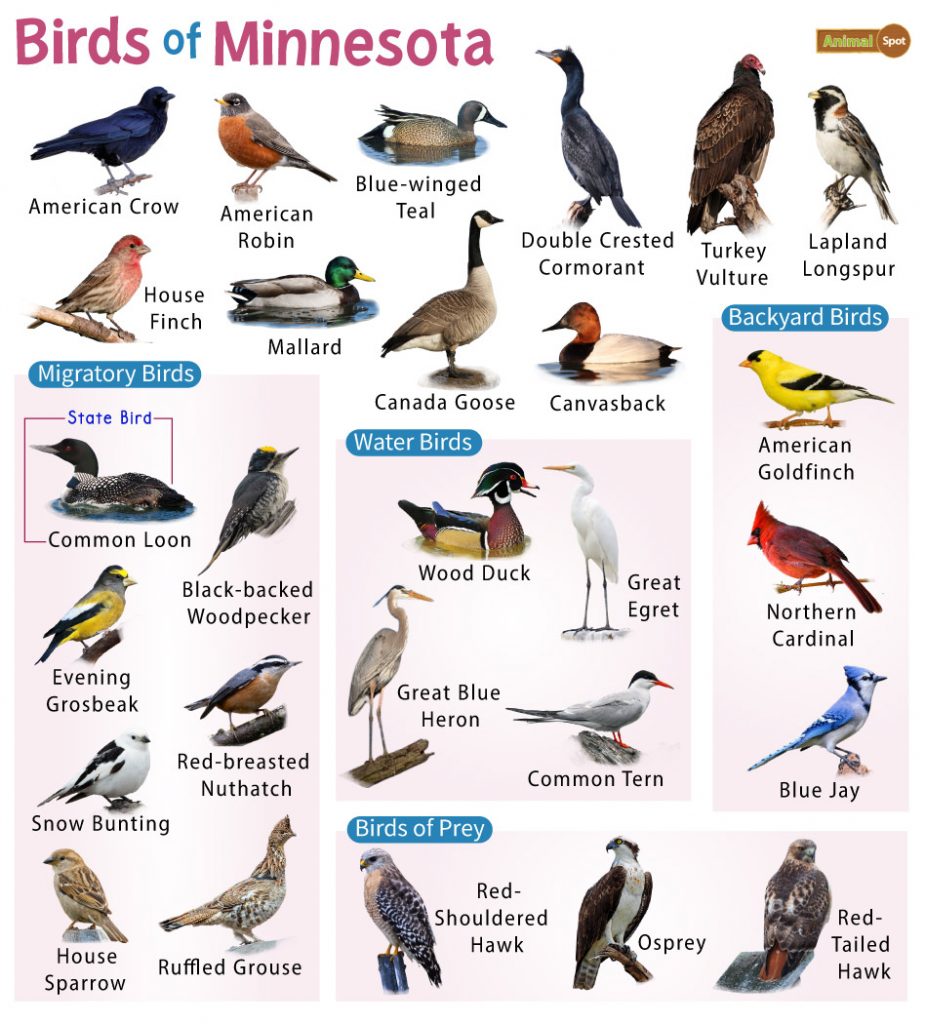
Species Accounts
Black-capped Chickadee
The Black-capped Chickadee is the most common bird species in Minnesota. With its distinctive black cap and bib, white cheeks, and buff-colored sides, it is easy to identify. Chickadees are small birds, measuring about 4.7 to 5.9 inches in length. They have short, slender bills that are perfect for feeding on seeds, insects, berries, and suet. Black-capped Chickadees are known for their cheerful songs and can often be heard singing their “chick-a-dee-dee-dee” call.
American Crow
The American Crow is a large, all-black bird that is commonly seen in Minnesota. It has a heavy bill, a thick neck, and long legs. Crows are about 16 to 21 inches long, making them much larger than the Black-capped Chickadee. They are highly intelligent and are known for their problem-solving abilities. Crows are scavengers and will eat almost anything, including carrion, insects, fruits, and grains.
American Robin
The American Robin is a familiar bird with its bright orange breast and gray-brown back. It is slightly larger than the Black-capped Chickadee, measuring about 9 to 11 inches in length. Robins have a distinctive upright posture and are often seen hopping across lawns in search of worms and insects. They also eat berries and fruits. Robins are migratory birds and can be found in Minnesota during the spring and summer months.
Blue Jay
The Blue Jay is a boldly colored bird with its blue feathers, white chest, and black collar. It has a crest on its head that can be raised or lowered depending on its mood. Blue Jays are about 9 to 12 inches long, similar in size to the American Robin. They have strong bills that are adapted for cracking nuts and acorns. Blue Jays are known for their loud calls and are often seen flying noisily through the trees.
American Goldfinch
The American Goldfinch is a small, brightly colored bird that is commonly seen in Minnesota. It has bright yellow feathers and a black cap on its head. Goldfinches are about 4.3 to 5.1 inches in length, making them smaller than the Black-capped Chickadee. They have short, conical bills that are perfect for feeding on seeds. American Goldfinches are often found in flocks and can be seen visiting bird feeders during the winter months.
Downy Woodpecker
The Downy Woodpecker is a small woodpecker with black and white feathers. It has a white belly, black wings with white spots, and a small bill. Downy Woodpeckers are about 5.5 to 6.7 inches long, similar in size to the Black-capped Chickadee. They are often found hopping up and down tree trunks in search of insects. Downy Woodpeckers also eat seeds and berries. Their drumming sounds can be heard throughout Minnesota’s forests.
White-breasted Nuthatch
The White-breasted Nuthatch is a small bird with a bluish-gray back and a white front. It has a black cap on its head and a long, slender bill. Nuthatches are about 5.9 to 6.3 inches long, similar in size to the Black-capped Chickadee. They are known for their unique behavior of climbing down tree trunks headfirst. White-breasted Nuthatches primarily eat insects, seeds, and nuts and can be found in woodlands and suburban areas.
Identification and Characteristics
Photographs
Photographs of each bird species can be found in the accompanying visual guide. These photographs will help you visualize the distinct features and colors of each bird, making it easier to identify them in the field.
Size and Shape Descriptions
Each bird species has its own unique size and shape characteristics. Understanding these descriptions can aid in identifying birds based on their physical appearance. For example, the Black-capped Chickadee is small and compact, while the American Crow is much larger and has a heavier bill.
Bill Types
The bill type of a bird provides clues about its preferred food sources. For example, the short, slender bill of a Black-capped Chickadee is ideal for feeding on seeds and insects. On the other hand, the strong bill of a Blue Jay is adapted for cracking nuts and acorns. Understanding bill types can help you determine which foods to offer when attracting birds to your backyard.
Attracting Birds to Your Backyard
Creating the Right Environment
To attract birds to your backyard, it is important to create an environment that meets their specific habitat needs. Different bird species have different habitat preferences. Providing a variety of vegetation, including trees, shrubs, and flowers, can create a suitable habitat for various birds. Additionally, offering water sources such as birdbaths or ponds can attract birds that require water for drinking and bathing.
Using Bird Feeders
Bird feeders are a great way to attract birds to your backyard. There are many different types of feeders available, including tube feeders, platform feeders, and suet feeders. It is important to choose the right feeder for the bird species you want to attract. Different birds have different feeding preferences, so offering a variety of foods, such as seeds, suet, and nectar, can attract a wider range of birds.
Providing Birds with Food
In addition to bird feeders, providing natural food sources can also attract birds to your backyard. Planting native vegetation that produces fruits, berries, and seeds can provide a natural food source for birds. Leaving dead trees or snags in your yard can also attract woodpeckers and other cavity-nesting birds that rely on decaying wood for nesting and feeding.
Bird Watching in Minnesota
Popular Spots for Bird Watching
Minnesota is known for its diverse bird population and offers many great locations for bird watching. Popular spots include state parks, wildlife refuges, and nature centers. Some notable locations include the Minnesota Valley National Wildlife Refuge, the Sax-Zim Bog, and the Hawk Ridge Nature Reserve. These areas provide excellent opportunities to observe a wide range of bird species in their natural habitats.
Best Time for Bird Watching
The best time for bird watching in Minnesota is typically during the spring and fall migration seasons. Many bird species pass through the state during these times, making it a prime opportunity to see a variety of birds. The arrival of migratory species, such as warblers and shorebirds, can create exciting birding experiences. Additionally, early morning and late afternoon are generally the best times to observe birds when they are most active.
Resources for Further Information
For those interested in learning more about bird watching in Minnesota, there are several resources available. The Minnesota Ornithologists’ Union (MOU) is a great organization to get involved with. They offer birding field trips, educational programs, and provide a wealth of information on birding in the state. Additionally, websites such as the Minnesota DNR and eBird provide up-to-date birding hotspots, checklists, and other valuable information for bird enthusiasts.
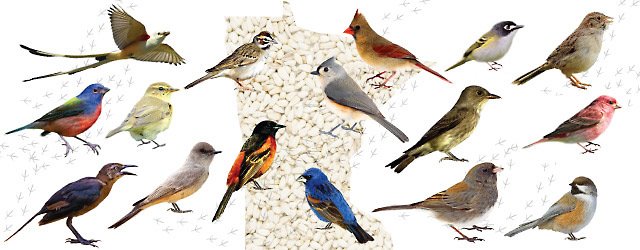
Species Account: Black-capped Chickadee
Description
The Black-capped Chickadee is a small, non-migratory bird with a distinctive black cap and bib, white cheeks, and buff-colored sides. It has a short, stout bill and a plump body. The Black-capped Chickadee measures about 4.7 to 5.9 inches in length.
Habitat
Black-capped Chickadees can be found in various habitats, including deciduous and coniferous forests, woodlands, and suburban areas. They are adaptable birds and can easily adjust to different environments as long as there are suitable trees and shrubs for nesting and foraging.
Feeding Habits
Black-capped Chickadees primarily feed on insects, seeds, berries, and suet. They are known for their acrobatic foraging behavior, often hanging upside down from branches while searching for food. They can be attracted to bird feeders that offer sunflower seeds, suet, or nyjer seeds.
Species Account: American Crow
Description
The American Crow is a large, all-black bird with a heavy bill, a thick neck, and long legs. It measures about 16 to 21 inches in length, making it much larger than the Black-capped Chickadee.
Habitat
American Crows are highly adaptable and can be found in a variety of habitats, including forests, farmlands, cities, and suburban areas. They are often seen perched in trees or on poles, scanning the ground for food.
Feeding Habits
American Crows are scavengers and will eat a wide range of food, including carrion, insects, fruits, grains, and even small animals. They are known for their feeding habits and can often be seen gathering in groups to search for food.
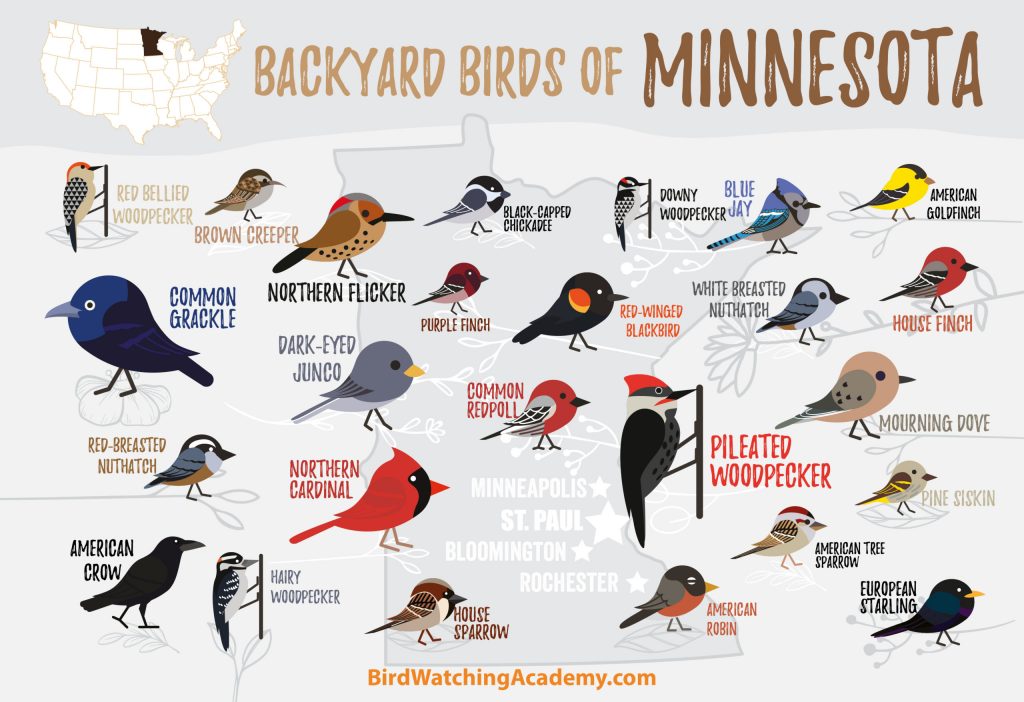
Species Account: American Robin
Description
The American Robin is a familiar bird with a bright orange breast, gray-brown back, and a white eye ring. It has a distinctive upright posture and measures about 9 to 11 inches in length.
Habitat
American Robins can be found in a variety of habitats, including forests, woodlands, parks, and suburban areas. They are often seen hopping across lawns in search of worms and insects.
Feeding Habits
American Robins primarily feed on earthworms, insects, and fruits. They will often be seen pulling up worms from the ground or plucking berries from trees. Offering mealworms, suet, and fruit can attract American Robins to your backyard.
Species Account: Blue Jay
Description
The Blue Jay is a boldly colored bird with blue feathers, a white chest, and a black collar. It has a crest on its head that can be raised or lowered. Blue Jays measure about 9 to 12 inches in length.
Habitat
Blue Jays can be found in various habitats, including forests, woodlands, parks, and suburban areas. They are often seen flying through the trees with a loud and distinctive call.
Feeding Habits
Blue Jays have a varied diet and eat a wide range of food, including acorns, nuts, seeds, berries, insects, and even small vertebrates. They are known for their tendency to cache food, storing it for later use. Offering a variety of nuts, seeds, and suet can attract Blue Jays to your backyard.
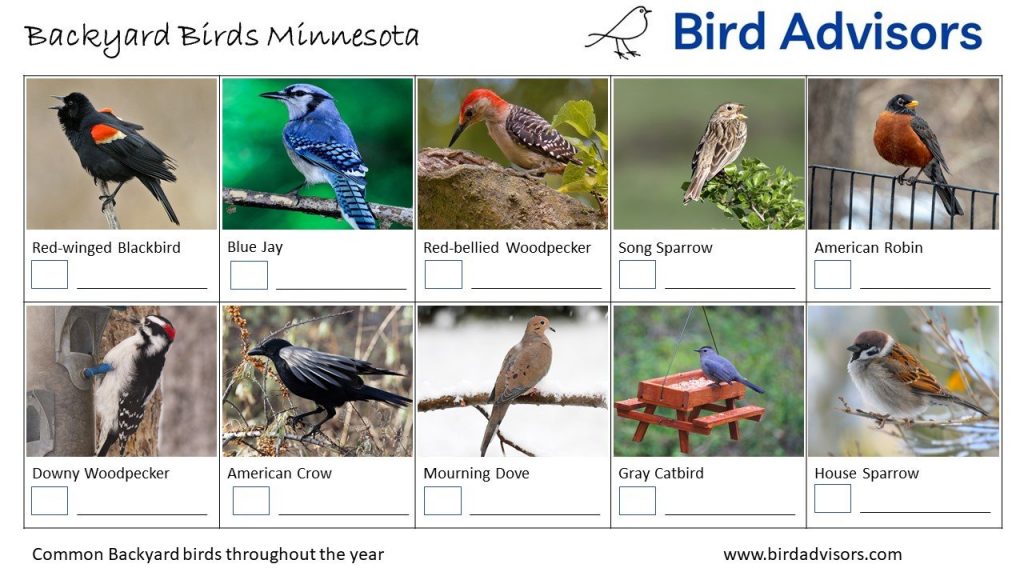
Species Account: American Goldfinch
Description
The American Goldfinch is a small, brightly colored bird with bright yellow feathers and a black cap on its head. It measures about 4.3 to 5.1 inches in length.
Habitat
American Goldfinches can be found in various habitats, including meadows, fields, open woodlands, and suburban areas. They are often seen in flocks, especially during the winter months.
Feeding Habits
American Goldfinches primarily feed on seeds, especially those of thistles and sunflowers. They have a unique feeding technique that involves hanging upside down from seedheads to extract the seeds. Offering nyjer seeds and sunflower seeds can attract American Goldfinches to your backyard.
Species Account: White-breasted Nuthatch
Description
The White-breasted Nuthatch is a small bird with a bluish-gray back, a white front, and a black cap on its head. It measures about 5.9 to 6.3 inches in length.
Habitat
White-breasted Nuthatches can be found in various habitats, including woodlands, forests, and suburban areas. They are often seen climbing down trees headfirst in search of insects and food.
Feeding Habits
White-breasted Nuthatches primarily feed on insects, seeds, and nuts. They have a unique behavior of wedging larger seeds or nuts into tree bark and hammering them open with their bill. Offering suet, peanuts, and sunflower seeds can attract White-breasted Nuthatches to your backyard.
In conclusion, understanding the identification, characteristics, and habits of common backyard birds in Minnesota can enhance your birding experience. By creating the right environment, using bird feeders, and providing birds with suitable food sources, you can attract a diverse range of bird species to your backyard. Additionally, exploring popular bird watching spots in Minnesota and utilizing resources for further information can expand your knowledge and appreciation for these magnificent creatures. Happy birding!
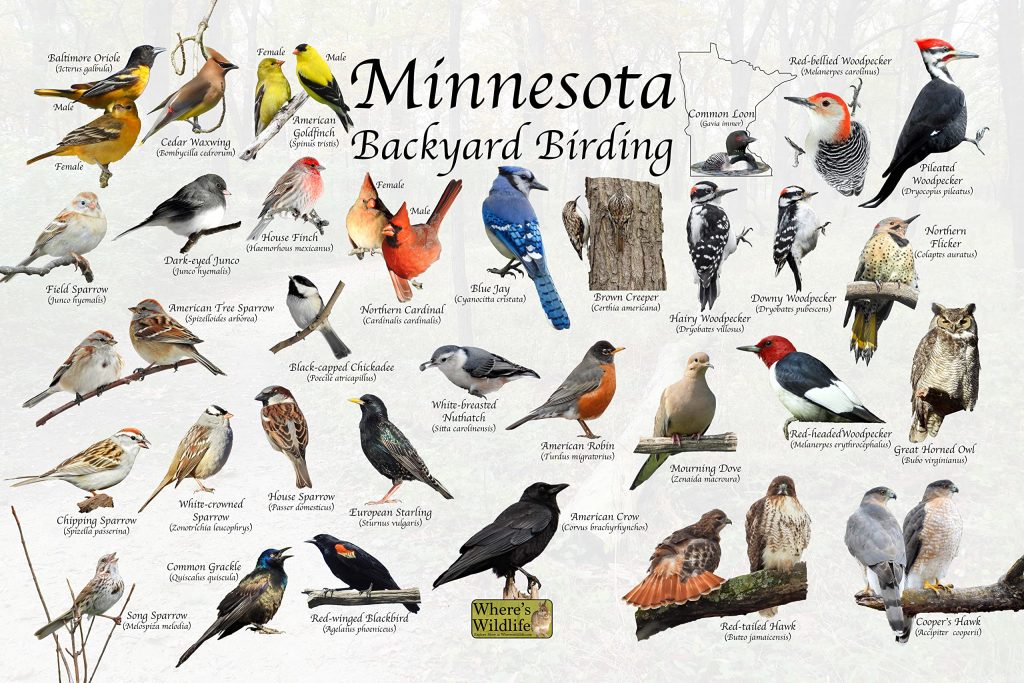
Leave a Reply